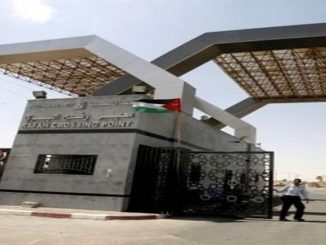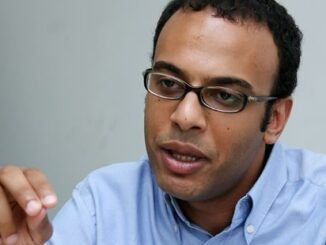
Ethiopia‘s Renaissance Dam could displace millions of Egyptians and Sisi should be held fully responsible for this national disaster, an article by David Hearst in the Middle East Eye states.
Hearst says the disaster of the Grand Ethiopian Renaissance Dam (GERD) struck not so much with a bang, but with a trickle – when at first, Ethiopia denied the very thing that 100 million Egyptians living downstream on the Nile feared – that the filling of the GERD reservoir had started. David Hearst went on saying:
On 15 July, Ethiopia’s national television broke the news, only to retract and apologise for it hours later. Ethiopia’s minister for water, irrigation and energy, Seleshi Bekele, initially claimed photographs published by Reuters showed water from “heavy rains”.
But after Sudan confirmed that several of its Nile stations had gone out of service from a sudden decline in the river’s waters, Ethiopia was forced to come clean. “Congratulations! It was the Nile River and the river became a lake. It will no longer flow into the river. Ethiopia will have all the development it wants from it. In fact, the Nile is ours!”
Incredibly, this victory roll was performed by the foreign minister himself, Gedu Andargachew, shedding all semblance of diplomacy.
A dream comes true
For Ethiopia, the dam is the fulfilment of a dream dating back to the Emperor Haile Selassie in the 1960s. The $4.6bn project “for Ethiopians by Ethiopians” (it was self-funded) is not just a way of providing electricity to a power-hungry nation, the dam is the cornerstone of the nation’s political and economic renaissance. Further, it means that Ethiopia can no longer be pushed around by colonial powers as it has been in the past.
It hosts the headquarters of the African Union and the United Nations Economic Commission for Africa. It has a powerful, battle-hardened army. Exactly the reverse path from regional power to basket case that’s being trodden by Abdel Fattah el-Sisi’s Egypt.
Under Sisi, Egypt’s national debt has nearly tripled since 2014, from about $112bn to around $321bn. A report by Egypt’s official Central Agency for Public Mobilisation and Statistics showed that poverty reached 32.5 percent in 2019, from 27.8 percent in 2015, while extreme poverty reached 6.2 percent from 5.3 percent for the same time periods.
Its population, which has already broken through the 100m barrier, is increasing by a million every six months, a rate that the UN predicts will lead to water shortages in five years’ time, even without the dam.
Eighty percent of the water that reaches Egypt comes from Ethiopia. A study by the Geological Society of America in May 2017 predicted that the country would suffer a 25 percent shortage in its annual water quota if the reservoir was filled in five to seven years.
A senior Egyptian source, who was involved in negotiations, told MEE: “If the dam is filled in three years as the Ethiopians want, the water level of the Nile in Egypt will be low to the extent that a lot of pipes of the pumps will be exposed.
“When this level becomes as low as this, the Delta, the most fertile area of Egypt, if this level of the Nile came down, the water of the sea will come in, which means the soil of the Delta will be salty and not suitable for a lot of agriculture.”
A terminal descent
In 2018, Reuters published a report saying that 17 percent of Egypt’s agricultural land would be destroyed if Ethiopia filled the reservoir in six years; and 51 percent if it filled in three years. Egyptian experts expect that 75 per cent of fish farms would be destroyed.
This could lead to the displacement of as many as 30 million people, one third of the population. If anything could be called a national emergency, it is the moment when the life-giving water level of the Nile starts its long and terminal descent. But the dam did not just happen. It was not a surprise.
Construction started in earnest in 2011. Soon afterwards, Mohamed Morsi became president and he was rightly concerned.
In an attempt to give himself some leverage at the negotiating table, Morsi said that “all options” were on the table in considering Egypt’s response to the project.
The Nile has always been the top national security issue for Egypt in the modern era. Egypt went to war with Ethiopia in 1874 in a failed attempt to control the Blue Nile.
A US embassy cable dated from 2010 and subsequently published by WikiLeaks revealed that Egyptians had blown up equipment on its way to Ethiopia in the mid 1970s.
The source, whose reliability was rated A by his US handlers and who was in touch with Hosni Mubarak and his director of military intelligence, Omar Suleiman, told the Americans: “There will not be a war. If it comes to a crisis, we will send a jet to bomb the dam and come back in one day, simple as that.
“Or we can send our special forces in to block/sabotage the dam. But we aren’t going for the military option now. This is just contingency planning. Look back to an operation Egypt did in the mid-late 1970s, I think 1976, when Ethiopia was trying to build a large dam. We blew up the equipment while it was travelling by sea to Ethiopia. A useful case study.”
But Morsi was ridiculed by opposition deputies and undermined by the army for talking tough.
Sisi’s plot
Three days before a crisis meeting with Morsi about the dam, Ayman Nour, one of the politicians involved in mediation with other African nations about the proposed structure, was contacted by Sisi himself.
Nour revealed last year that he was briefed by Sisi that Morsi wanted to explore the option of military action, but that the army was not prepared for that, and that the whole file should be dealt with by the army alone.
The Morsi meeting was sabotaged. Morsi’s aides were told that a camera was recording the proceedings for internal communication, whereas in fact everything they thought they were discussing in confidence was being broadcast live. Sisi’s purpose was clear. His focus was to embarrass his president one month before Morsi himself was deposed.
Nour said: “This meeting was part of a plot to embroil Egypt in a big problem relating to the Renaissance Dam. It was part of the endeavour to prove the failure of the ruling regime at that stage.”
Sisi had another reason for putting the brakes on a robust Egyptian response to the dam.
He knew that in a month’s time, when he carried out his military coup, the African Union would suspend Egypt’s membership. The AU’s suspension – which was the only significant international reaction to the coup – lasted just one year and Sisi’s dove-ish noises with Ethiopia played their part in ending Egypt’s isolation.
When Sisi and the army took over the file, they told the Ethiopians that Egypt was now in sensible, rational hands who would negotiate. The days of the wild Islamists were over, they said.
But negotiations got nowhere.
The green light
A “preliminary” tripartite deal was signed between the leaders of Egypt, Sudan and Ethiopia in 2015.
At the signing ceremony, the Ethiopian Prime Minister Hailemariam Desalegn said in earnest: “I confirm the construction of the Renaissance Dam will not cause any damage to our three states and especially to the Egyptian people,” he said. Sisi replied: “This is a framework agreement and it will be completed. We have chosen cooperation, and to trust one another for the sake of development.”
This was repeated when, in 2018, Sisi asked the new Prime Minister of Ethiopia Abiy Ahmed to repeat after him in Arabic “By Allah, By Allah we shall not cause any harm to Egypt’s water”. Sisi was laughing and clapping as Ahmed mouthed words he did not understand. Ahmed does not speak Arabic.
The cumulative effect of declarations it had no intention of enforcing was that Ethiopia got the green light to go ahead. Five more wasted years have passed and the dam has become a fact on the ground.
Few options
Try as Sisi might to divert attention elsewhere – such as threatening to send troops to Libya to counter the Turkish-armed fightback of the government in Tripoli – the filling of the dam is a massive blow to the Egyptian army’s claim to be the protectors of the state. The army is being ignored, its true impotence revealed by a more powerful and more confident African neighbor.



